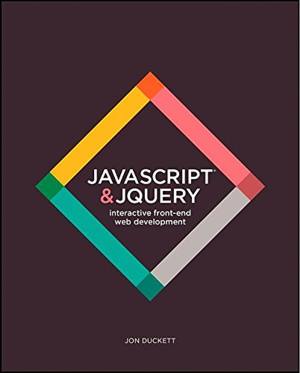| JavaScript and JQuery |
|
Author: Jon Duckett JavaScript and JQuery are a good way to create interactive front-ends and this is what this book is all about. This is a very unusual book and its approach will only suit the complete beginner with a limited technical background. This is not a book for programmers and certainly not for experts. It makes things look simple using a combination of large clear print and lots of pictures. It puts very little actual information on a single page and this is the reason it has 640 pages. It is also very task-oriented. It doesn't really go in for explaining the principles, philosophy or the bigger picture. This is about using JavaScript and jQuery to get particular tasks done. The book is very pretty, clear and stylish and it is very much targeting web designers who wants to add some code to their HTML. For this reason the book assumes that you know all there is to know about HTML and CSS (if you don't there is a companion volume also by Jon Duckett on this topic) and the JavaScript is nearly always illustrated within the context of an HTML page. This is practical, but it also has the disadvantage of sometime making it harder to see the principle being explained. You do need to be very happy with reading HTML to get very far with this book, despite its apparent simplicity.
The book starts from the really basic ideas - what is a program, how to web browsers work, what is an object and so on. It is difficult to explain how slow the presentation is but it takes 40 pages to get to running a JavaScript program. Some times there are just one small piece of information on a two page spread lavishly illustrated in the style of a glossy magazine. After the very basics, we move on to start learning JavaScript proper. The strange thing is that, despite this being a very slow and very simple introduction, topics are included in the order you might find them in any programming primer. First we get a definition of what a statement is, comments and variables. The section on variables is typical of the approach - two facing pages, the left saying var quantity; and the right saying quantity=3; with very neat and tidy blocks of text explaining what they mean. If you like O'Reilly's Head First books with their chaotic notes, scribbled pictures, jokes, crosswords, quizzes and so on, you will hate this carefully laid out, stylish, presentation. The presentation also has a tendency towards completism. Instead of not telling the reader about some of the awkward twists in the language the book tends to explain everything at the risk of confusing the complete beginner. For example, just after introducing the idea of a variable we have storing a string in a variable and then storing a Boolean. Then we have a detailed 6-point set of rules for naming variables. By the end of the section we have dealt with a range of data types, arrays and expressions. From here we move into functions, methods and objects. After introducing object literals - the simplest possible use of object the book introduces constructors and here things get more difficult. Even if you go slowly and use big print things begin to look more difficult. Notice that the introduction to objects happens well before more basic things like control structures - for loops, ifs etc. Then moves on to consider other aspects of objects - built-in objects, data types and so on.
It is not until Chapter 4 (page 144) do we reach what many would consider the core of programming - decisions and loops. In this case the topic can be put off until so late because the object of the book is to write JavaScript that interacts with the DOM, and to be honest you really don't get deeply involved in algorithms doing this. The way that diagrams and short blocks of text are used do give the reader a good chance of understanding these ideas. From here the book returns to getting the job done with a look at the DOM in detail and then the important topic of events. Chapter 7 introduces jQuery and Chapter 8 explains Ajax and JSON. jQuery can be a difficult library to understand and while at the end of this you don't get to understand it you should be able to use it. After a jQuery the topics covered include APIs, error handling and debugging, content panels, filtering, searching and sorting and forms. This is a very well-designed book. It doesn't do anything radical and it certainly doesn't attempt to make the reader into a computer scientist. This is about learning programming to get a very particular job done. Having said this, if the reader has any aptitude for programming this book might help them discover it and then graduate to something more. If you find the clear "big typeface" colorful presentation helpful, then this might be the book that gets you started with programming. I have a feeling that it is also going to create quite a few readers who sort of manage to master bits of it, forget others and then end up being very vague about why things work. Even so it still comes highly recommended to the right reader.
|
|||
| Last Updated ( Wednesday, 19 November 2014 ) |

